- EasyCard
- Trade
- Help
- Announcement
- Academy
- SWIFT Code
- Iban Number
- Referral
- Customer Service
- Blog
- Creator
What currency is used in Poland in 2025
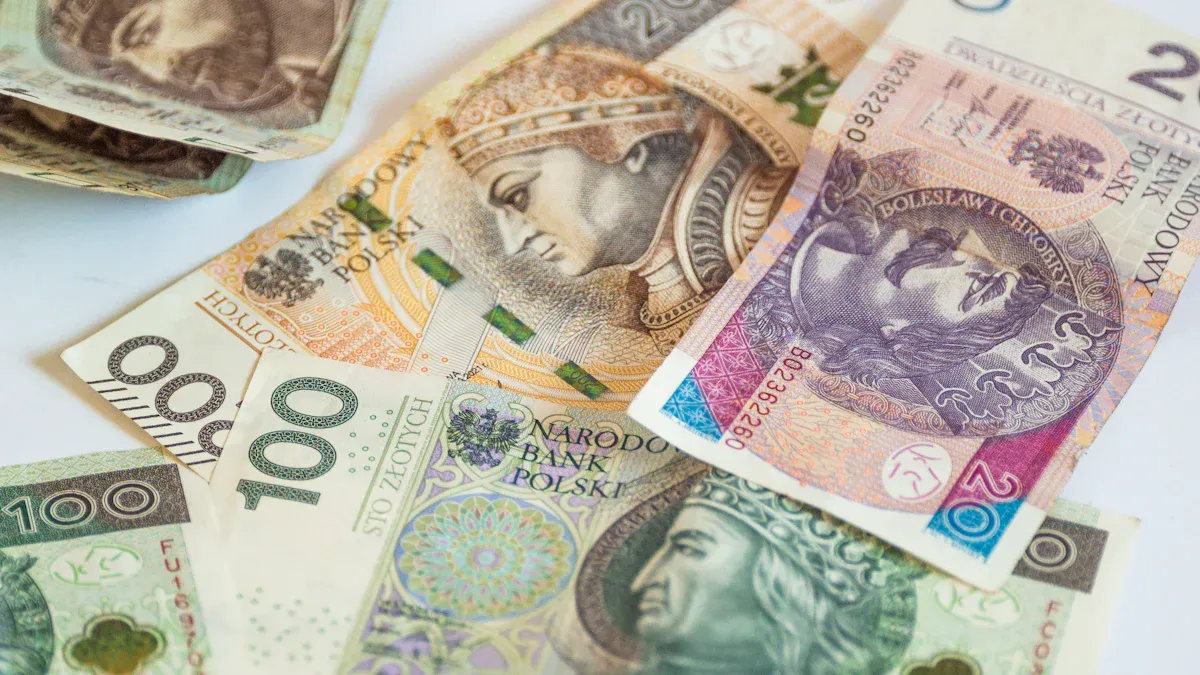
Image Source: pexels
You will use the Polish zloty as the official currency in Poland in 2025. The zloty, with the code PLN, stands as the only legal way to pay for goods and services. Every store, restaurant, and service provider accepts only the Polish currency. When you exchange money in Poland, you get zloty. The value of the zloty changes throughout the year. For example, on July 31, 2025, 1 PLN equals about 0.27 USD.
| Date | PLN to USD Rate |
|---|---|
| July 31, 2025 | 1 PLN = 0.26699 USD |
| Highest in 2025 | 1 PLN = 0.2778 USD |
| Lowest in 2025 | 1 PLN = 0.2402 USD |
You must use PLN for all payments, as no other currency used in Poland counts as legal tender. When you handle money in Poland, remember to ask for your change in zloty.
Key Takeaways
- Poland uses only the Polish zloty (PLN) for all payments in 2025; no other currency is accepted legally.
- Bring some zloty cash for small purchases, tips, and places that do not accept cards, especially outside big cities.
- Use major bank ATMs or kantor exchange offices in Poland for the best currency exchange rates and avoid airport or hotel exchanges.
- Pay in zloty when using cards or ATMs to avoid extra fees and decline dynamic currency conversion.
- Digital payments like BLIK and card payments are common in cities, but always carry cash as a backup for rural areas and small vendors.
Polish Currency Overview
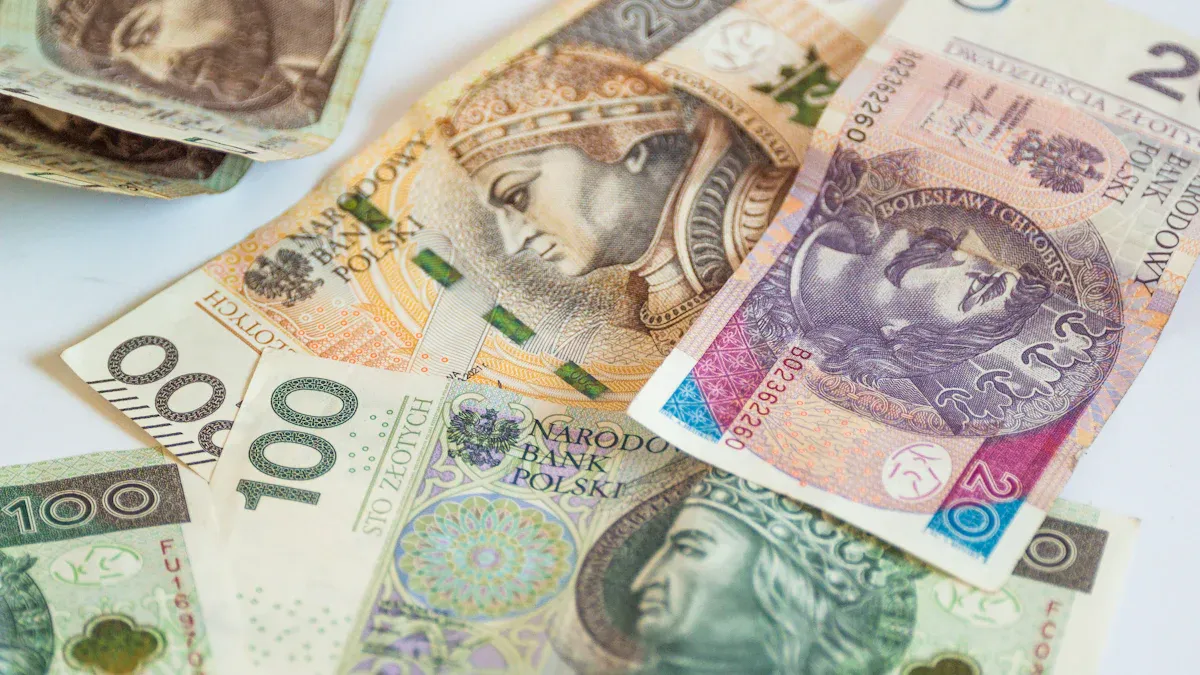
Image Source: pexels
Polish Zloty (PLN)
You will use the Polish zloty as the official polish currency in 2025. The zloty uses the symbol zł and the code PLN. You cannot use any other polish currency for payments in Poland. The zloty has a long history. The word “zloty” first appeared in the 15th century, when it described gold coins used in trade. In 1924, Poland reintroduced the zloty after a period of instability. The new zloty replaced the old Polish marka and helped stabilize the economy. Over the years, the zloty survived wars, political changes, and economic reforms. The new zloty introduced in 1995 remains the only legal tender in Poland today. The polish zloty stands as a symbol of Poland’s independence and resilience.
Note: The polish zloty remains stable in 2025. You will see only minor changes in its value against the US dollar. This stability helps you trust the polish currency for your daily needs.
Denominations and Symbol
You will find both coins and banknotes when you use the polish zloty. The symbol for the zloty is zł, and the code is PLN. Coins come in values called groszy and zloty. Here is a table showing the coins you may use:
| Denomination | Description |
|---|---|
| 1 grosz | Smallest coin, bronze plated steel, serrated edge |
| 2 grosze | Slightly larger, bronze plated steel, plain edge |
| 5 groszy | Larger, bronze plated steel, alternating smooth and serrated edge |
| 10 groszy | Cupronickel, alternating smooth and serrated edge |
| 20 groszy | Serrated edge, cupronickel |
| 50 groszy | Largest grosz coin, cupronickel |
| 1 zloty | Bimetallic, alternating smooth and serrated edge |
| 2 zloty | Bimetallic, aluminum bronze ring with cupronickel center |
| 5 zloty | Bimetallic, cupronickel ring with aluminum bronze center |
You will also use banknotes in the following values: 10, 20, 50, 100, 200, and 500 zloty. The new zloty banknotes include advanced security features. For example, you may see color-shifting threads and micro-optic effects that help prevent counterfeiting. Some new zloty notes even have special designs to honor Polish history.
Issuing Authority
The National Bank of Poland, known as Narodowy Bank Polski, issues and regulates the polish currency. This bank controls the supply of the polish zloty and ensures its stability. The National Bank of Poland follows strict rules set by the Polish Constitution and national laws. You can trust that the new zloty you use in 2025 meets high standards for security and quality.
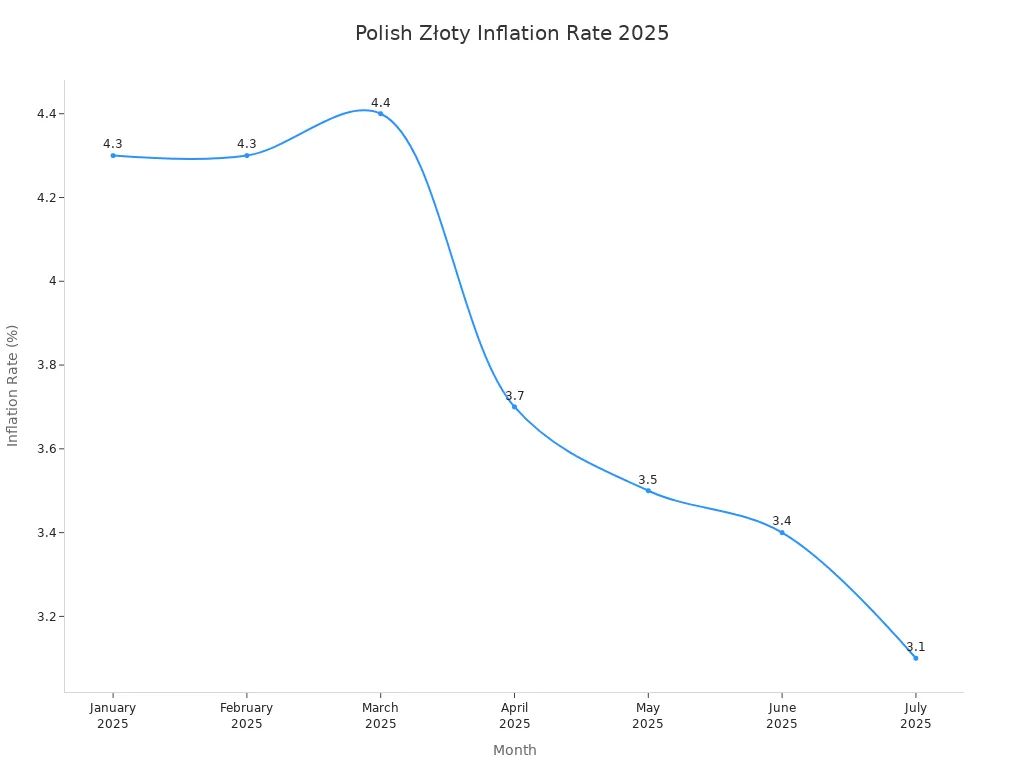
You will notice that inflation for the polish zloty in 2025 stays low, with rates dropping from 4.3% in January to 3.1% in July. This trend shows that the new zloty keeps its value well, making it a reliable polish currency for your trip or daily life.
Currency Used in Poland
Legal Tender Status
You will find that the only currency used in Poland in 2025 is the Polish zloty. Every shop, restaurant, and service provider accepts only the zloty for payments. When you pay for goods or services, you must use zloty banknotes or coins. No other currency used will work for daily transactions. The law in Poland states that the zloty is the only legal tender. If you try to pay with euros or US dollars, most places will not accept them. You should always expect to receive your change in zloty as well. This rule makes it easy to understand how to use money in Poland. You do not need to worry about which currency to bring for shopping or dining. The zloty is the answer every time.
Use of Foreign Currencies
You might think that Poland, as a member of the European Union, would accept the euro. In reality, the currency used in Poland is not the euro. Most stores, hotels, and attractions will not take euros or US dollars. Only a few places near airports or tourist spots may accept foreign currencies, but this is rare and often comes with poor exchange rates. You will get a better value by exchanging your money for zloty before making purchases. The zloty is not accepted outside Poland, so you cannot use it in other countries. When you leave Poland, you should exchange any leftover zloty back to your home currency. This step helps you avoid holding onto money in Poland that you cannot spend elsewhere.
Currency in Poland for Travelers
When you travel to Poland, you need to plan how to get and use the currency in Poland. You will face some challenges if you try to use foreign money. Here are some things you should know:
- You must exchange your home currency for zloty or use cards that convert your money automatically.
- Credit cards like Visa and MasterCard work in many places, but you may pay extra fees and get less favorable exchange rates.
- Many small vendors, market stalls, and public toilets require cash, often in small denominations.
- Some public transport ticket machines only accept cash, especially coins.
- Regional bus tickets may only be available for cash from the driver.
- Shops in cities like Warsaw sometimes stop accepting cards and ask for cash instead.
- Card terminals may not always work, so you should carry some cash as a backup.
- Many people in Poland carry cash for small purchases, tickets, and public toilets.
- Avoid withdrawing cash from Euronet ATMs because they charge high fees.
- You will get better exchange rates at kantor exchange offices than at banks.
Using money in Poland means you need to prepare for both card and cash payments. You should always have some zloty in your wallet for small expenses. This habit will help you avoid problems when card payments fail or when you need to buy something quickly. If you want to know how to use money in Poland, remember to check the latest exchange rates. For example, if 1 PLN equals 0.27 USD, you can estimate the cost of your purchases easily. The currency used in Poland is reliable and easy to manage if you plan ahead.
Best Currency to Take to Poland
Exchanging Money
When you plan your trip, you may wonder about the best currency to take to poland. You should bring a small amount of Polish zloty for your first expenses, such as transport or snacks. Most travelers bring their home currency, like USD or EUR, and exchange it for zloty after arriving. This is often the best way to exchange currency because you get better exchange rates in Poland than at home. Avoid exchanging money at airports or hotels, as these places usually offer poor rates and high fees. Instead, look for a reliable currency exchange service in city centers or use a bank. Always check the posted exchange rates before you agree to a transaction. If you want to exchange money before travelling to poland, remember that banks outside Poland rarely have zloty and may charge high fees.
Using ATMs and Kantor
You will find ATMs everywhere in Poland, including airports, shopping centers, and convenience stores. ATMs support international cards and often have English menus. Withdrawing cash from a major bank ATM is one of the best ways to exchange currency. Bank ATMs usually charge low or no fees, but independent ATMs in tourist areas may charge more. Always choose to be charged in Polish zloty to avoid extra costs. Kantor offices are another answer to where to get polish zloty. These currency exchange kiosks are common in city centers and tourist spots. Kantors often offer better exchange rates than banks and usually do not charge commissions, but always confirm before exchanging. Some Kantors stay open late or even 24 hours in busy areas.
Tips for Getting the Best Rates
To get the best currency to take to poland, follow these tips:
- Compare exchange rates at different places before you exchange money.
- Use bank-affiliated ATMs and avoid dynamic currency conversion.
- Withdraw larger amounts less often to reduce fees.
- Use online apps to check live exchange rates.
- Choose reputable Kantors and ask for the rate in writing.
- Carry both cash and cards for flexibility.
- Avoid exchanging at airports, hotels, or late-night Kantors.
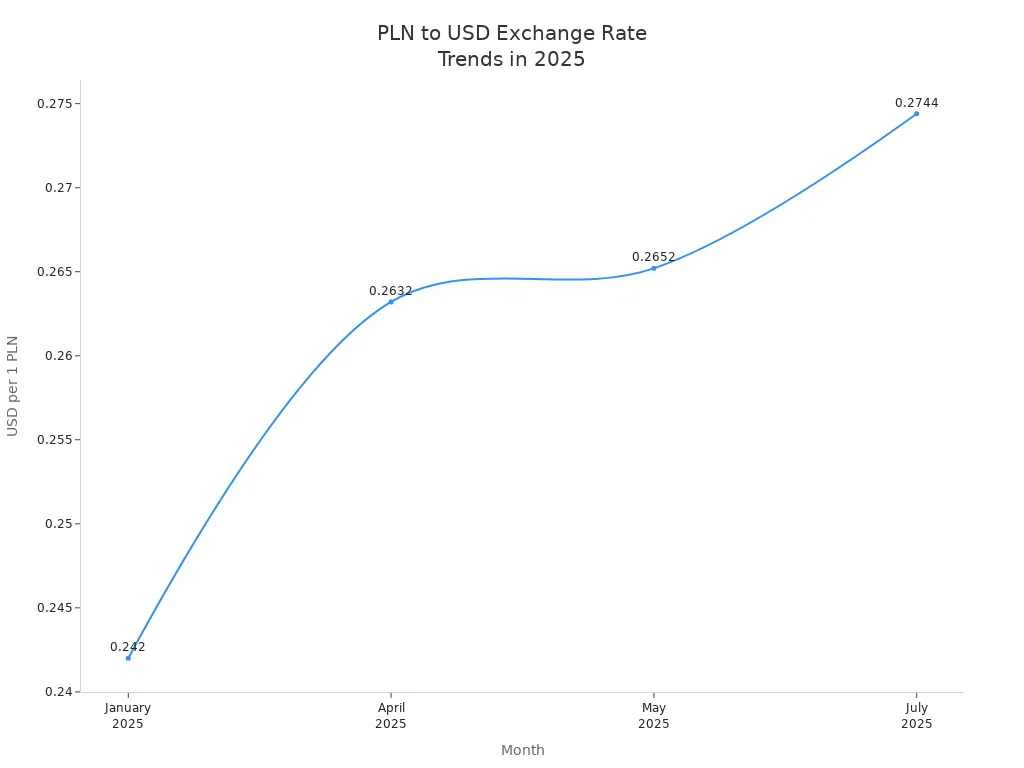
You should know where to get polish zloty and the best ways to exchange currency. Always use a trusted currency exchange service to avoid scams. The exchange rates for the zloty change during the year, so check the latest rates before you travel.
Payment Methods in Poland
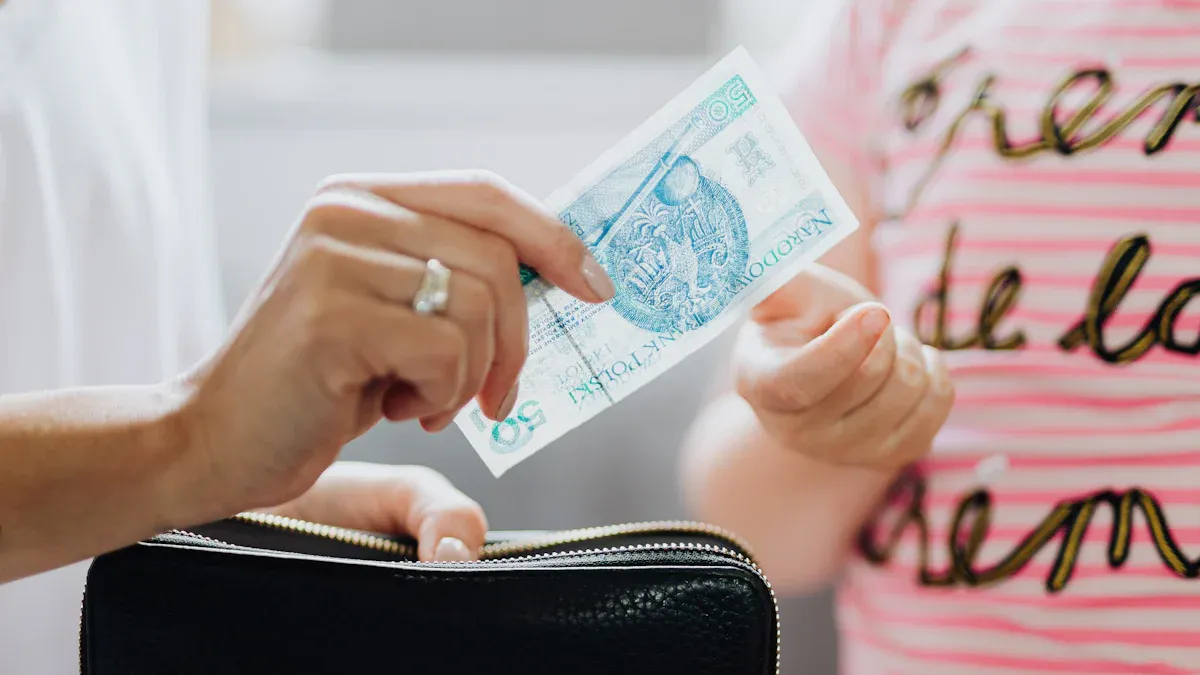
Image Source: pexels
Cash vs. Card
You will notice that both cash and card payments are common in Poland. The Polish government’s Cashless Poland Program has helped increase the number of payment terminals to over 1 million. This makes it easy for you to use your card in most shops, restaurants, and hotels. Many people now receive their salaries by bank transfer, which encourages the use of debit cards. Card payments, including contactless options, are growing quickly. You can use Visa, Mastercard, and even mobile wallets like Apple Pay or Google Pay. However, cash still plays a role in daily life. Some small businesses, market stalls, and public toilets accept only cash. When you travel outside major cities, you may find fewer places that take cards. You should always carry some zloty for small purchases or emergencies.
- Card payments are increasing, but cash remains important for:
- Small purchases
- Tipping
- Rural areas
- Certain markets and festivals
Tip: Carry about $81 (zł295) in cash or accessible funds each day to cover meals, sightseeing, and local transport.
Digital Payments
Digital payments have become very popular in Poland. You can use BLIK, a mobile payment system, for online shopping and in many stores. BLIK is the most popular digital payment method, used by over half of all shoppers. Other options include instant bank transfers, card payments, and digital wallets. The table below shows the popularity of different digital payment methods in 2025:
| Payment Method | Popularity (%) | Key Characteristics |
|---|---|---|
| BLIK | 51 | Mobile payment system; main choice for online payments. |
| Instant Bank Transfers | 22 | Secure, preferred by traditional users; slower process. |
| Card Payments (Visa, Mastercard) | 10 | Widely accepted; easy to use with digital wallets. |
| Cash on Delivery | 7 | Pay when you receive your order; still used for some products. |
| Traditional Bank Transfers | 3 | Used by businesses or traditional clients; slowest option. |
| Buy Now, Pay Later (BNPL) | 3 | Lets you pay later; good for expensive items. |
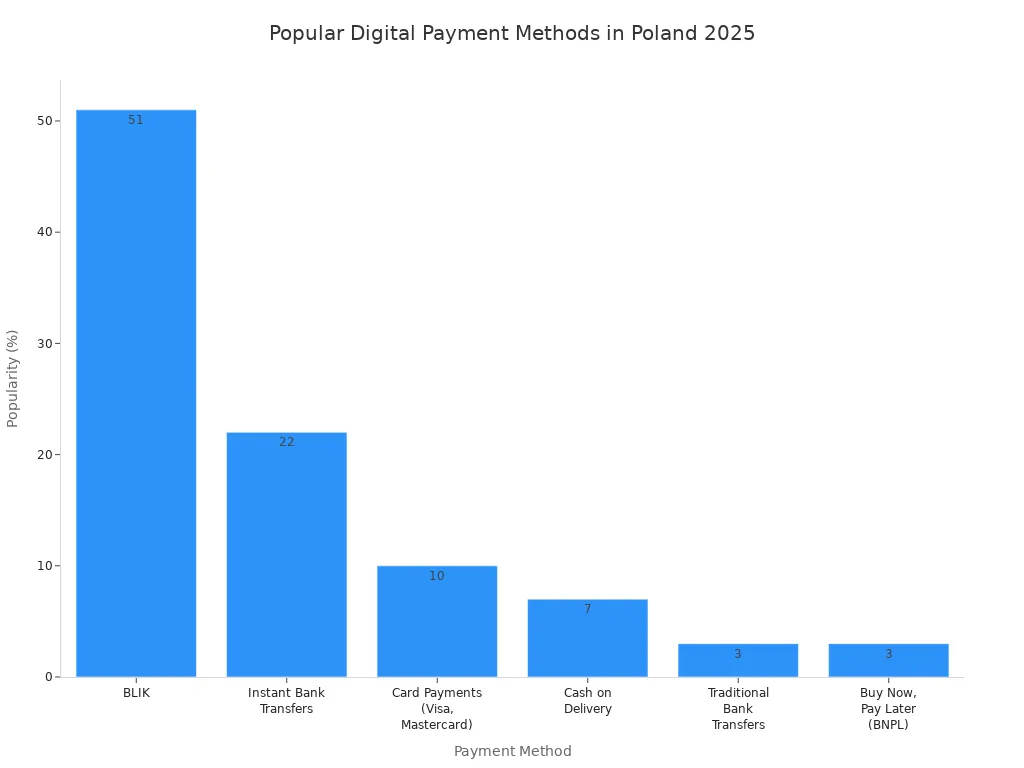
You will find that digital payment systems in Poland use strong security features. Providers use multi-factor authentication, encryption, and advanced fraud detection. These steps help protect your money and personal information. Still, some people feel safer using cash, especially for larger purchases.
When to Use Each
You should choose your payment method based on where you are and what you need to buy. In big cities, you can use cards or digital payments almost everywhere. For online shopping, BLIK and card payments are the most accepted payment methods in poland. When you visit rural areas or small towns, cash becomes more important. Some places, like Christmas markets or small shops, may only accept zloty in cash. Tipping hotel staff, taxi drivers, or tour guides also usually requires cash. If you plan to explore outside tourist areas, always keep some zloty with you.
- Use cards or digital payments for:
- Hotels, restaurants, and supermarkets
- Online shopping
- Public transport in cities
- Use cash for:
- Small purchases
- Local markets and festivals
- Tipping and emergencies
- Rural or remote locations
You will find that the zloty is the only currency accepted for all these payment methods. Always check if a place accepts cards before you order or shop. Keeping a mix of cash and cards gives you the most flexibility during your stay in Poland.
You will use the Polish zloty (PLN) as the only official currency in Poland in 2025. To get the best value, use ATMs for withdrawals and always pay in zloty instead of dollars or euros.
- Avoid exchanging large amounts of cash, as you may lose 5-15% on fees.
- Decline dynamic currency conversion at ATMs and card readers.
- Choose cards with no foreign transaction fees.
Always carry some small zloty notes and coins for minor purchases or tips. This helps you avoid confusion and makes daily spending easier.
FAQ
Can you use euros or US dollars for shopping in Poland?
You cannot use euros or US dollars for shopping in Poland. Shops and restaurants accept only Polish zloty (PLN). Always check the latest exchange rate, such as 1 PLN ≈ 0.27 USD, before exchanging your money.
Where can you exchange money for Polish zloty?
You can exchange money at banks, ATMs, or kantor exchange offices. Kantors often offer better rates than banks. Avoid exchanging money at airports or hotels because they usually charge higher fees.
Do credit cards work everywhere in Poland?
You can use credit cards in most hotels, restaurants, and stores. Some small shops, markets, or public toilets accept only cash. Always carry some zloty for small purchases or emergencies.
What is the best way to get Polish zloty?
You get the best rates by withdrawing cash from a major bank ATM or exchanging money at a reputable kantor. Always choose to be charged in zloty, not USD, to avoid extra fees.
How much cash should you carry each day in Poland?
Most travelers carry about $81 (zł295) per day for meals, transport, and sightseeing. You may need more cash in rural areas or for small purchases. Always keep some small notes and coins for convenience.
This guide shows you that while the Polish zloty is the only official currency, navigating its use can be tricky. You have to find reliable kantors, avoid shady ATMs, and constantly watch out for unfavorable exchange rates or hidden fees. These manual steps and risks can take away from your travel experience. You need a financial solution that is as modern as Poland’s cities and as transparent as the country’s history. This is where BiyaPay offers a modern, transparent, and direct solution that eliminates the friction of traditional currency exchange. Our platform provides real-time exchange rate queries and conversions, with remittance fees as low as 0.5%, giving you the best possible value on every transaction.
Instead of hunting for an exchange office or worrying about ATM fees, you can manage your funds with ease from anywhere. BiyaPay gives you the peace of mind to focus on your trip, knowing that your funds are accessible and your conversions are transparent. Our platform supports multiple fiat and digital currencies, allowing for seamless transfers and financial flexibility. Don’t let confusing exchange rates and high fees slow you down. Open a secure account with BiyaPay in minutes and experience a new standard for global finance. Register now to simplify your travel expenses.
*This article is provided for general information purposes and does not constitute legal, tax or other professional advice from BiyaPay or its subsidiaries and its affiliates, and it is not intended as a substitute for obtaining advice from a financial advisor or any other professional.
We make no representations, warranties or warranties, express or implied, as to the accuracy, completeness or timeliness of the contents of this publication.




Contact Us
Company and Team
BiyaPay Products
Customer Services
is a broker-dealer registered with the U.S. Securities and Exchange Commission (SEC) (No.: 802-127417), member of the Financial Industry Regulatory Authority (FINRA) (CRD: 325027), member of the Securities Investor Protection Corporation (SIPC), and regulated by FINRA and SEC.
registered with the US Financial Crimes Enforcement Network (FinCEN), as a Money Services Business (MSB), registration number: 31000218637349, and regulated by FinCEN.
registered as Financial Service Provider (FSP number: FSP1007221) in New Zealand, and is a member of the Financial Dispute Resolution Scheme, a New Zealand independent dispute resolution service provider.




















